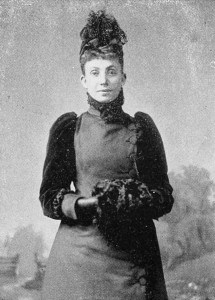It took Lew Wallace almost 30 years to write and publish his first novel, The Fair God. He started working on it at about the age of 19 in the 1840s and published it in 1873 at age 46. After the success of his first book, it took him approximately seven years to write and publish his second book, Ben-Hur. Other books he completed did not take so long, but he clearly worked with diligence and care; he did not publish his efforts until fully satisfied. By the turn of the 20th century, Wallace focused his efforts on the writing of his autobiography.
Researching the Autobiography
In April of 1901, Lew travelled to Louisville and hosted a grand dinner. The papers reported that he was in town to gather data for his memoirs, which he had been working on for some time. He stayed at the Louisville Hotel. According to the newspapers he expected to be done with the book by Christmas of 1901 at which time he would begin writing his first “American” novel.
The Autobiography’s Scope
Wallace told reporters his autobiography would cover all the periods of his varied and eventful life. He planned to give special attention to his careers as governor of New Mexico and minister to Turkey. The book would also cover the important aspects of his military career. Researching the Civil War is what took him to Louisville in 1901. As he stated:
“I am here to see some of the distinguished confederates who fought in the great battles of the civil war [sic] and to get their personal experiences…[T]he best history is that which is not burdened with dull data, but enlivened by personal accounts. I have already seen Gen. Duke, who was a war-time opponent, and Gen. Buckner. I will also see Col. J. Stoddard Johnston. I intend to visit the library of Col. R.T. Durrett.”
Lew was particularly interested in securing information from the Confederates on the Battle of Shiloh. On April 26, Wallace hosted his formal dinner for former adversaries in the Louisville Hotel with guests General S.B. Buckner, General Basil W. Duke, Colonel J. Stoddard Johnston, Major D.W. Sanders, Captain John W. Leathers, Logan C. Murray, James S. Barret, and Marmaduke Bowden.
Simon Bolivar Buckner
General Simon Bolivar Buckner was a graduate of the U.S. Military Academy at West Point and had seen significant fighting in the Mexican War. A Kentuckian, Buckner turned down high ranking positions in the Union Army before ultimately deciding to serve the Confederacy. In the Civil War, Buckner again saw action, including at Fort Donelson in 1862.
Buckner commanded Fort Donelson when it was attacked by the Union forces led by his old friend, Ulysses Grant. When defeat at Donelson appeared inevitable, Buckner sent a message to Grant requesting an armistice. He wanted a meeting of commissioners to negotiate surrender. Instead, Grant famously responded with his words: “No terms except unconditional and immediate surrender can be accepted. I propose to move immediately upon your works.” Buckner quickly surrendered the fort. Grant treated Buckner courteously following the surrender. Grant even offered to loan Buckner money to see him through his impending imprisonment, but Buckner declined.
The surrender humiliated Buckner personally. In addition, it proved a strategic defeat for the Confederacy, which lost more than 12,000 men and much equipment. After the surrender, the Union took control of the Cumberland River, which led to the evacuation of Nashville. Lew had been friends with Buckner before the war. Also, he was heavily involved in the battle for Fort Donelson. As a result, Lew was keenly interested in visiting with Buckner in 1901.
Basil W. Duke
Confederate Basil W. Duke, of Kentucky, was John Hunt Morgan’s brother-in-law. He rode along with Morgan’s guerilla invasions in southern Indiana and Ohio during the war. Governor Oliver P. Morton had dispatched Lew Wallace to chase Morgan out of Indiana. Also, Duke had been wounded in the Battle of Shiloh. When Duke died in 1916, historians lauded him, saying, “No Southerner was more dedicated to the Confederacy than General Basil W. Duke.”

Lew sought to interview many other men. Colonel J. Stoddard Johnston, Major D.W. Sanders, Captain John W. Leathers, Logan Murray, Marmaduke Bowden, and James Barret each had their important stories to share from their Civil War experiences. Lew Wallace sought to build relationships with former adversaries in the years after the Civil War, as this dinner shows. Efforts such as these by Grant, Lee, Wallace, and other Civil War leaders from both sides proved vital to mending the sectional divisions created by the war.
Lew’s Death
As Wallace’s autobiography progressed, it grew larger in scope. He did not finish it by Christmas of 1901. By the time Lew died in February of 1905, he was only about half-way through his personal recollections. When he put his pen down for the final time, he was working on his memories of the Battle of Monocacy, which took place in 1864. Wallace approached the work in a largely chronological format, so he had not penned many of the most important aspects of his life.
Completion of the Autobiography
Throughout her life, Susan Wallace had supported her husband’s creative efforts. The autobiography was no exception. After Lew’s death, Susan and her friend Mary Hannah Krout took it upon themselves to finish the work Lew had started. In a little over a year, Susan and Mary Hannah completed Lew’s autobiography. They published the two-volume work in 1906. Just as the autobiography proved to Lew’s last major creative effort, it was also Susan’s last major work. She died less than a year after its publication.
The autobiography can be purchased in print or e-book addition from Amazon.
Sources:
The Crawfordsville Journal, April 17, 1901
The Crawfordsville Journal, April 26, 1901
3 thoughts on “Lew Wallace and his Autobiography”